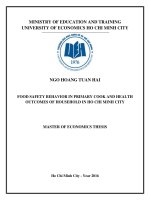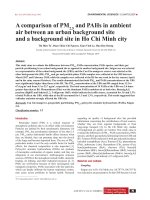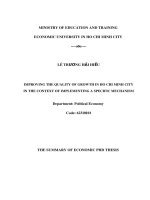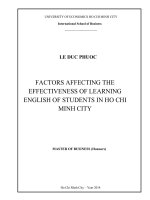The effects of perceived justice with service recovery on customer satisfaction, loyalty and word of mouth in restaurant services in ho chi minh city
Bạn đang xem bản rút gọn của tài liệu. Xem và tải ngay bản đầy đủ của tài liệu tại đây (963.02 KB, 78 trang )
UNIVERSITY OF ECONOMICS HO CHI MINH CITY
International School of Business
------------------------------
Truong Ngoc Quang Duy
THE EFFECTS OF PERCEIVED JUSTICE WITH SERVICE
RECOVERY ON CUSTOMER SATISFACTION, LOYALTY AND
WORD OF MOUTH IN RESTAURANT SERVICES IN
HOCHIMINH CITY
MASTER OF BUSINESS (Honours)
Hochiminh City – 2015
UNIVERSITY OF ECONOMICS HO CHI MINH CITY
International School of Business
------------------------------
Truong Ngoc Quang Duy
THE EFFECTS OF PERCEIVED JUSTICE WITH SERVICE
RECOVERY ON CUSTOMER SATISFACTION, LOYALTY AND
WORD OF MOUTH IN RESTAURANT SERVICES IN
HOCHIMINH CITY
ID: 22130014
MASTER OF BUSINESS (Honours)
SUPERVISOR: Dr. PHAM NGOC THUY
Hochiminh City – 2015
ACKNOWLEDGEMENT
Firstly, I would like to express my deep gratitude to my supervisor, Dr. Pham Ngoc
Thuy, for her expertly instructions over the course. Without her insight and professional
guidance, I would not complete this study.
I would also like to send deeply thanks to all members of ISB’s Committee for their
valuable advices and constructive comments, which helped me in correcting this research.
Finally, I’m so grateful my family, my close friends, and my colleagues for
encouraging and supporting me for all the time.
STATEMENT OF DECLARATION
I hereby certify that this thesis and its contents are my own work and effort, as part of
my Master of Business studies. All the sources of information and materials used in this
study have been fully acknowledged.
Signature:……………………………….
Date:…………………………………….
ii
LIST OF CONTENTS
ACKNOWLEDGEMENT ............................................................................................... ii
STATEMENT OF DECLARATION .............................................................................. iii
LIST OF CONTENTS ...................................................................................................... iv
LIST OF TABLES ............................................................................................................ vi
LIST OF FIGURES .......................................................................................................... vii
ABSTRACT ....................................................................................................................... viii
CHAPTER 1: INTRODUCTION ................................................................................... 1
1.1
1.2
1.3
Research background ............................................................................................... 1
Statement of problem ............................................................................................... 2
Research objectives ................................................................................................. 3
1.4
1.5
Scopes of the study .................................................................................................. 3
Significance of the study ......................................................................................... 4
1.6
Thesis structure ........................................................................................................ 4
CHAPTER 2: LITERATURE AND HYPOTHESES ................................................... 5
2.1
2.2
2.3
Overview research context ...................................................................................... 5
Definitions of concepts ............................................................................................ 7
Relationships between main concepts ..................................................................... 11
2.4
Proposed research model ......................................................................................... 14
CHAPTER 3: RESEARCH METHODOLOGY ........................................................... 17
3.1
3.2
3.3
3.4
Sample size .............................................................................................................. 17
Research process ...................................................................................................... 18
Pilot study results ..................................................................................................... 20
Questionnaire design ............................................................................................... 26
3.5
Data analysis method ............................................................................................... 27
iii
CHAPTER 4: DATA ANALYSIS ................................................................................... 29
4.1
4.2
4.3
Sample characteristics ............................................................................................. 29
Validity Analysis - Exploratory Factor Analysis .................................................... 31
Reliability Analysis – Cronbach’s Alpha Analysis ................................................. 35
4.4
Regression Analysis................................................................................................. 37
4.4.1 Simple regression analysis ....................................................................................... 37
4.4.2 Multiple regression analysis .................................................................................... 40
CHAPTER 5: CONCLUSIONS, IMPLICATIONS, AND LIMITATIONS .............. 48
5.1
5.2
Findings ................................................................................................................... 48
Managerial implications .......................................................................................... 49
5.3
Limitations and future research ............................................................................... 51
REFERENCES.................................................................................................................. 52
APPENDICES ................................................................................................................... 57
Appendix A: Research questionnaire (Vietnamese version) .............................................. 57
Appendix B: Research questionnaire (English version) ..................................................... 61
Appendix C: Output summary of pilot study ..................................................................... 65
Appendix D: KMO and Bartlett’s Test results for all variables (before and after deleted one
unsuitable item)................................................................................................................... 69
iv
LIST OF TABLES
Table 2.1: Summarize hypotheses of the research.............................................................. 14
Table 3.1: Original measurement scales for the variables ................................................ 22
Table 3.2: Measurements comparison table ...................................................................... 24
Table 4.1: Respondents’ demographic characteristics description ................................... 30
Table 4.2: Rotated Component Matrix of all variables (first test) ..................................... 33
Table 4.3: Rotated Component Matrix of all variables (after deleted one item) ............... 34
Table 4.4: Reliability test results for all variables ............................................................. 36
Table 4.5: Correlations test of simple regression analysis ................................................ 38
Table 4.6: ANOVA of simple regression analysis .............................................................. 39
Table 4.7: Coefficients of simple regression analysis ........................................................ 40
Table 4.8: Correlations test of multiple regression analysis.............................................. 41
Table 4.9: Model summary of multiple regression analysis ............................................... 42
Table 4.10: ANOVA of multiple regression analysis .......................................................... 42
Table 4.11: Coefficients of multiple regression analysis ................................................... 43
Table 4.12: Summary of regression analysis and hypotheses testing ................................ 46
v
LIST OF FIGURES
Figure 2.1: Proposed research model ................................................................................ 15
Figure 3.1: Research process ............................................................................................. 18
Figure 4.1: Revised research model ................................................................................... 35
vi
ABSTRACT
Retaining customers’ loyalty and attracting new customers is the target of every
company in every business. In order to reach that target, their managers always try to satisfy
the customers at the utmost capability. However, in some unexpected circumstances, the
firms cannot avoid some mistakes or service failures throughout the service process
(Komunda & Osarenkhoe, 2012). Hence, satisfying customers by service recovery plays an
important role in reducing the damage in relationship between the firms and customers after
service failures (Kau & Loh, 2006). In the world, justice theory has been a significant
approach for service recovery research (Wen & Chi, 2013). However, still little research has
demonstrated its effects to customer loyalty and its relationship with word-of-mouth
intentions, especially in Vietnam.
According to Vietnam Competition Authority - Ministry of Industry and Trade’s
annual report (2015), restaurant is one of the industries which received most of complaints.
The purpose of this study is to examine the effects of perceived justice to customer
satisfaction with service recovery, and the relationships between customer satisfaction with
service recovery, loyalty, and word-of-mouth in restaurant sector. Using a structured
questionnaire, a survey is conducted with 304 appropriated respondents. As a result, the
research found that four justice dimensions (i.e., distributive justice, interactional justice,
procedural justice, and informational justice) had positive relationships with customer
satisfaction with service recovery, in which, distributive justice was the factor which
influenced to customer satisfaction with service recovery the most, following by
interactional justice, informational justice, and procedural justice respectively. Besides, the
study confirms also the positive impact of customer satisfaction with service recovery to
customer loyalty and word-of-mouth. After these findings, the managerial implications as
well as research’s limitations are also presented.
vii
CHAPTER 1
INTRODUCTION
1.1 Research background
Every company does want to satisfy their customers, to compete with the rivals by
supplying high quality products and/or service, competitive price, and excellent customer
services, etc… However, even a company which gained a lot of experiences in customer
services cannot avoid service failures, which are identified as failures of core service, or
products and policy failures (Komunda & Osarenkhoe, 2012). Service failures occur
throughout the service delivery process, and possibly lead to many consequences as
complaints and dissatisfactions. In fact, customer complaints are natural consequences in
any industry or any service activity, not only because making mistake is an unavoidable
feature of human being (Michel et al., 2009; Rio-Lanza et al., 2009), but also because of
non-human errors (Kau & Loh, 2006).
Customers, who are not satisfied with any service of the firm, tend to have
antipathies to the firm, and turn to be the customers of other competitors, or even become a
negative communication channel of the firm. Therefore, service recovery is a very important
activity, as a second effort of the firms, in order to retain the customers to the company or at
least, “reduce the damage in relationship” (Kau & Loh, 2006, p.111), and to maintain a
positive image of the company in customers’ mind after service failures.
In order to examine the relationship between service recovery and customer
satisfaction toward such activities, many researchers employ and focus on the justice theory
(Tax et al., 1998; Smith et al., 1999), meanwhile some studies examine emotional
perspective to evaluate customer satisfaction with service recovery from failures (Varela1
Neira et al., 2010; Wen & Chi, 2013). Even there are other approaches which have been
explored to explain the customers’ complaint satisfaction, including “outcome complaint
satisfaction” and “process complaint satisfaction” (Stauss, 2002, p. 176), or evaluating
service recovery from disconfirmation perspective (McCollough et al., 2000), perceived
justice theory provides a significant approach for service recovery research (Wen & Chi,
2013). In many studies, there are three dimensions of perceived justice in service recovery
context which have been suggested are distributive justice, procedural justice, and
interactional justice (Tax et al., 1998; Smith et al., 1999). However, in recent studies,
informational justice is examined as the fourth dimension of service recovery perceived
justice (Mattila & Cranage, 2005; Varela-Neira et al., 2010; Badawi, 2012).
In line of service recovery and customer satisfaction, many researchers mention trust
as a consequence of satisfaction though its relationship with loyalty still unclear (Tax et al.,
1998; Kau & Loh, 2006). In addition, as a finding, previous studies which examined service
recovery justice, have together confirmed the effects of customer satisfaction with service
recovery to customer behavior of patronage intention (Tax et al., 1998; Stauss, 2002) and
word-of-mouth (Kau & Loh, 2006; Wen & Chi, 2013).
1.2 Statement of problem
In Vietnam, restaurant industry has been developed significantly recently; serve
millions of people every year, including Vietnamese and foreign travelers. However,
according to the Vietnam Competition Authority - Ministry of Industry and Trade’s annual
report (2015) about the number of complaints of customers received in 2014, restaurant was
one of the industries which received most of complaints. From a preliminary survey in many
restaurants in Hochiminh city, there are many complaints from customers. Most of
2
complaints are related to the service ability (deliver wrong dishes, or not in a timely manner,
etc…), staffs’ attitudes, service procedures, or about the environment (Vo & Pham, 2013).
More than that, customers usually concern about the service quality of restaurants
while providing the recovery service after failures, including attitudes of employees, service
time for the recovery, adequate explanations, or the results of recovery compare with their
expectations, etc… These practices are interpreted in literatures of customers’ justice
perception, customer satisfaction, loyalty, and word of mouth in recent researches. In
contrast, although many studies have analyzed the relationship between perceived justice
and customer satisfaction in service failure and recovery situations, still little research has
demonstrated its effects to customer loyalty and its relationship with word-of-mouth
intentions.
1.3 Research objectives
This study aims to examine the effects of perceived justices to customer satisfaction
with service recovery, including four dimensions (i.e., distributive justice, interactional
justice, procedural justice, and informational justice).
The study also investigates the relationships between customer satisfaction with
service recovery, loyalty, and word-of-mouth in restaurant sector.
1.4 Scopes of the study
The objects of this study are customers that visiting the restaurants, suffering service
failures, and have been provided service recoveries from such restaurants in Hochiminh city.
The study will approach these customers, interview them for the problems, and conduct the
survey in order to collect data for the research.
3
1.5 Significance of the study
Successful service recoveries often help customers to rate the firm more favorably
after the recovery than prior to the failure (Choi & Choi, 2014). There is no denying that
satisfaction with service recovery is a critical factor in ensuring customer loyalty (Choi &
Choi, 2014; Stauss, 2002). Understanding of which factors effect to customer satisfaction in
service recovery take a significant role in helping the managers of restaurant services
companies to achieve and retain customer loyalty, which will lead to re-purchase activities
and positive word-of-mouth.
1.6 Thesis structure
This thesis is structured into five chapters. Firstly, introduction chapter presents an
outline of this research. This chapter starts with background of the research, raises the
research problems which explain the motivation for doing this research. Besides, this
chapter raises research objectives, the scopes of study, and significances of this research in
practice. Secondly, chapter two reviews and summaries the literatures of related concepts
from previous studies, including customer justice perception, customer satisfaction with
service recovery, customer loyalty, and positive word-of-mouth. This chapter also provides
the relationships of these concepts, and arguments the hypotheses, and then come to
proposed research model. Thirdly, chapter three introduces research methodology which
is used to empirically test the research model. After that, chapter four presents the results
of data analysis. Finally, chapter five ends this study with discussions the research’s
findings, points out limitations of this research, and suggestions for next studies.
4
CHAPTER 2
LITERATURE REVIEW AND HYPOTHESES
This chapter is going to generalize some prominent works related to the current topic,
and introduce the related literatures and concepts, which have been discovered in previous
studies. The mentioned concepts, including customer justice perception, customer
satisfaction to service recovery, customer loyalty, and word-of-mouth, are discussed in pair,
in order to argue the hypotheses, and construct to the model.
2.1 Overview research context
In previous studies, which have discovered service recovery efforts of service
providers, overall satisfaction is used to explain its affections, and its relationship with
loyalty, and word-of-mouth activities (Spreng et al., 1995; Davidow, 2003). Recently,
XiaoRan and Omar (2014) examine the relationship between service recovery activities and
customer overall satisfaction with recovery efforts. However, their studies only demonstrate
the effects of service recovery action to customer satisfaction, through justice dimensions as
mediator variables, without any further consequences or customers’ responses toward such
recovery activities.
Another study of Kau and Loh (2006) investigates the elements including trust,
word-of-mouth intention and consumer loyalty (i.e., commitment) as consequences of
customer satisfaction, examined both complainants and non-complainants to compare the
differences. It is found that customers who satisfied originally with the service expressed
greater trust and positive word-of-mouth than customers who satisfied after they received
service recovery from service providers (Kau & Loh, 2006).
5
In recent research, Choi and Choi (2014) investigate the effects of perceived service
recovery justice to customer affection, loyalty and word-of-mouth. The study finds out that
procedural and interactional justice perceptions significantly influence customer affection,
with distributive justice perception being significant only if the failure severity is high, and
customer affection influences the restoration of loyalty, which certainly lead to positive
word-of-mouth. Many researches, which investigate service failure and recovery, also
examine and support to customer satisfaction with service recovery as a key factor that
affect to customer loyalty, commitment and repurchase activities (Tax et al., 1998; Stauss,
2002; Kau & Loh, 2006; Osarenkhoe & Komunda, 2013, Wen & Chi, 2013). This frame
work is considered as a suitable model to investigate the effect of service recovery perceived
justice to customer intentions after suffering service failure.
In the context of this study, where restaurant service was investigated, the restaurants
may face to some failures during service delivery, from small mistakes to serious faults, e.g.
arranging seats tardily, delivery wrong dishes, or short delivery of dishes, serving in a
laggard manner, insanitary food, wrong billing, etc. These failures usually occur throughout
the core service process of restaurants, when the number of customers excesses the service
ability of the restaurant (Vo & Pham, 2013). In this circumstance, the restaurants are
required to response to the issues instantly as part of their service procedures and tasks. This
study will conduct a research with customers who raised the complaints and have been
provided service recoveries from restaurants after service failures. Other cases are excluded
from the framework of this study.
6
2.2 Definitions of concepts
Service recovery
Service recovery refers to an activity by which the firms handle the complaints from
customers, who dissatisfied with a part or whole of the provided services. It is considered as
a service encounter (Varela-Neira et al., 2010), or to be defined as a process, or specific
actions to resolve the problems occured in initial service delivery (Kau & Loh, 2006;
XiaoRan & Omar, 2014). An appropriated and effective service recovery strategy from
service providers may handle customer complaints successfully, and restore positive images
of the firms. Service recovery activities include the explanations about the service failures,
apologizing, solving the problems, and compensations (e.g., discounts, vouchers, free gifts,
etc.), in a respectful, polite manner (XiaoRan & Omar, 2014).
Customer justice perception
In the service recovery context, perceived justice literature is constructed
significantly when studying customer satisfaction. Perceived justice is recognized as a key
factor which affects the formation of customers’ evaluation on organizations’ responses to a
service failure (Tax et al., 1998; Varela-Neira et al., 2010). In many studies, perceived
justice is investigated by three independent dimensions, including distributive justice,
procedural justice, and interactional justice (Tax et al., 1998; Smith et al., 1999; Choi &
Choi, 2014).
Mattila and Cranage (2005) argue that offering the information relevant to a decision
will have an opportunity to influence the outcome of people’s fairness perceptions. As a
result, informational justice has been conducted as a fourth dimension of customer justice
perception in recent studies (Mattila & Cranage, 2005; Varela-Neira et al., 2010; Badawi,
7
2012). This study conducts the framework with four perceived justice dimensions, by
adding informational justice, which has been ignored in service recovery literature for a long
time.
These four dimensions are defined as following:
Distributive justice refers to the customer’s perception of the equity of the resources
allocation, and the tangible outcome of the service provider. According to Davidow
(2003), distributive justice is the “fairness of the outcome of the organization’s
response (p. 68). At the other hand, distributive justice concerns the perceived
fairness of specific outcomes of the firm’s recovery efforts (Choi & Choi, 2014). In a
study of Blodgett et al., distributive justice expresses the “perceived fairness of the
policies, procedures, and criteria used by decision makers in arriving at the outcome
of a dispute or negotiation” (as cited in Kau & Loh, 2006, p. 102). According to Tax
et al. (1998), distributive justice is identified with three elements, i.e., “equity,
equality, and need” (p. 62).
In the current study of Varela-Neira et al. (2010), procedural justice is defined as the
customer’s perception of the equity of the policies and procedures of the company to
handle the complaints that lead to the obtained outcome. Procedural justice is also
considered as “the perceived fairness of the procedures” (p. 111) while service
recovery is proceeding by service providers (Choi & Choi, 2014). Five elements of
procedural justice are described, i.e., “process control, decision control, accessibility,
timing/speed, and flexibility” (Tax et al., 1998, p. 62).
Another dimension is interactional justice, which refers to the manners by which
customers are treated, includes elements such as “attitude, courtesy, personal
8
interaction” (Choi & Choi, 2014, p. 111), in dealing with customers during a service
recovery process. As another approach of Maxham and Netemeyer, interactional
justice is related to the customer’s judgments of the equity of the personal treatment,
in terms of “respect, honesty, education and dignity” (as cited in Varela-Neira et al.,
2010, p. 91), or the quality of communication (Smith et al., 1999). Tax et al. (1998)
listed five important elements of interactional justice, including “provision of an
explanation, effort in resolving a problem, as well as politeness, concern, and
honesty” (p. 62) in the service recovery process.
In a current study, when informational justice literature has been explored
thoroughly, Mattila and Cranage (2005) define informational justice as the
“perceived adequacy and truthfulness of information” (p. 272), when explaining the
cause of failures. This justice relates to the validity, and focus on the fairness of
information using to clarify the reason of the events (Varela-Neira et al., 2010). In
another study, informational justice is considered as the equity of the explanations
and justifications from the firms (Ambrose et al., 2007).
Customer satisfaction with service recovery
Usually expectations, disconfirmation of expectations, and performance are used to
specific buyers’ level of satisfaction (Martenson, 2007). In this context of service recovery,
customer satisfaction results from an evaluation process where customers compare their
previous recovery expectations with their perception of the service recovery received
(Karande et al., 2007). In general, there are two types of customer satisfaction: transactionbased satisfaction and overall satisfaction. While most of other service failure studies were
concerned with overall satisfaction (Karande et al., 2007), this study will demonstrate
9
customer satisfaction with service recovery (complaint handling) and its relationship with
loyalty.
Customer loyalty
Loyalty refers to a commitment to re-buy or re-patronize a preferred product or
service consistently in the future (Oliver et al., 1997), a commitment to maintain a
relationship with the firm, including the patronizing repeatedly to the specific service
provider, engaging in positive word-of-mouth (Sirdeshmukh et al., 2002; Lam et al., 2004).
At the other hand, customer loyalty can be understood as customer’s commitment to do
business with a particular organization, purchasing their goods and services repeatedly, and
recommending the services and products to friends and associates (Osarenkhoe &
Komunda, 2013).
Word-of-mouth
Word-of-mouth is an activity that customer who experienced service failure and
received service recovery with give negative recommendations to others. In another study,
word-of-mouth is considered as “informal, person-to-person communication between a
perceived noncommercial communicator and a receiver regarding a brand, a product, an
organization, or a service” (Harrison-Walker, 2001, p. 63). Positive word-of-mouth not only
helps to attract new customers but also assists in the creation of positive image about the
firm concerned (Kau & Loh, 2006).
10
2.3 Relationships between main concepts
Customer justice perception and customer satisfaction with service recovery
Customers assess the level of justice of the service recovery and this perception of
justice which including three dimensions above influences their satisfaction with service
recovery. Tax et al. (1998) support that perceived justice has a positive impact on
satisfaction with service recovery. From their study, Kau and Loh (2006) also confirm that
customer justice perception is significantly and positively related to satisfaction with service
recovery, and distributive justice was found to have the greatest impact on customer
satisfaction.
In a recent study, Siu et al. (2013) investigate both customer satisfaction with the
recovery and overall satisfaction with organization. However, they find out that service
recovery perceived justices are not totally related to overall satisfaction with organization
(Siu et al., 2013). In accordance with Maxham (1998), perceived justice (including
distributive justice, procedural justice, interactional justice) is positively related to not only
specific transaction satisfaction, but also overall satisfaction with the firm. In another study,
Badawi (2012) finds out that perceived justice has a positive relationship with customer
satisfaction with complaint handling, and informational justice is seen as the strongest
variable to risen the level of customer satisfaction toward the service recovery. In the
previous studies of Mattila and Cranage (2005), Varela-Neira et al. (2010), the findings
support that all of four dimensions of justice, including distributive justice, procedural
justice, interactional justice, and informational justice, are highly linked to and help to
identify customer satisfaction with service recovery. Therefore, we hypothesize:
H1: Perception of distributive justice will have a positive affect to customer satisfaction
with service recovery.
11
H2: Perception of procedural justice will have a positive affect to customer satisfaction
with service recovery.
H3: Perception of interactional justice will have a positive affect to customer
satisfaction with service recovery.
H4: Perception of informational justice will have a positive affect to customer
satisfaction with service recovery.
Customer satisfaction with service recovery and customer loyalty
Customer satisfaction provides a leading indicator of consumer purchase intentions
and loyalty. Recent researches on customer complaint focus on the overall satisfaction of
customer with complaint handling of organization. Many researches support to the finding
that there is a strong positive relationship between the satisfaction with complaint handling
and the intensions to repurchase and commitment – elements of customer loyalty (Davidow,
2013; Tax et al., 1998). The findings of Kau and Loh (2006) also confirm that satisfaction
with service recovery had a strong impact on customer loyalty and also reinforce customer
commitment. Therefore, hypothesis is supposed:
H5: Customer satisfaction with service recovery will have a positive affect to customer
loyalty.
Customer satisfaction with service recovery and word-of-mouth
In the context of service failure and recovery, word-of-mouth is critical as those who
think they are treated unfairly and likely to spread negative word-of-mouth (Choi & Choi,
2014). While service recovery quality can be considered as a part of overall service quality,
a recent study of Osarenkhoe and Komunda (2013) show the finding that when a service is
12
considered totally satisfied, it may drives customers to recommend the firm’s products or
services to others.
From the earlier time of service recovery study, Spreng et al. (1995) demonstrate that
customers, who satisfied with service recovery, are intend to use the firm’s service in the
future, and would provide positive word-of-mouth. Kau and Loh (2006) conclude that
satisfaction with service recovery would encourage positive WOM communication. In
another study, it is argued that satisfied customers have a better relationship with service
providers and they will spread positive word-of-mouth to other people about the service
providers (Kruger & Mostert, 2014). Thus, this study hypothesizes this relationship as
following:
H6: Customer satisfaction with service recovery will have a positive affect to positive
word-of-mouth.
Customer loyalty and word-of-mouth
In the research of Sirdeshmukh et al. (2002), word-of-mouth is considered as one of
components of loyalty. However, the empirical findings by Soderlund (as cited in Choi and
Choi, 2014) suggest that word-of-mouth intentions should be regarded as separate constructs
and that the inclusion of word-of-mouth in the conceptualization of loyalty should be
avoided. In this context, customers who loyal with a service supplier are likely to give
positive recommendations to others and reverse, they are unlikely to give positive
recommendations to others if there is no loyalty to the firm.
In the study of Lam et al. (2004), they support that loyal customers will recommend
the service provider, whom they are loyal to; to other customers; and probability engage in
13
positive word-of-mouth behavior (Komunda & Osarenkhoe, 2012). Therefore, we
hypothesize:
H7: Customer loyalty will have a positive relationship with positive word-of-mouth.
Table 2.1: Summarize hypotheses of the research
Hi
Hypotheses
H1 :
Perception of distributive justice will have a positive affect to customer satisfaction
with service recovery.
H2 :
Perception of procedural justice will have a positive affect to customer satisfaction
with service recovery.
H3 :
Perception of interactional justice will have a positive affect to customer
satisfaction with service recovery.
H4 :
Perception of informational justice will have a positive affect to customer
satisfaction with service recovery.
H5 :
Customer satisfaction with service recovery will have a positive affect to customer
loyalty.
H6 :
Customer satisfaction with service recovery will have a positive affect to positive
word-of-mouth.
H7 :
Customer loyalty will have a positive relationship with positive word-of-mouth.
2.4 Proposed research model
The framework of current study proposes the positive affection of customer
perceived justice to customer satisfaction with service recovery. The four dimensions of
perceived justice have been mentioned in this study, including distributive justice,
14
procedural justice, interactional justice, and informational justice, are separately
demonstrated.
As discussed, this model expresses the role of customer satisfaction with service
recovery as the mediator between customer justice perception and word-of-mouth, and
independent variable of customer loyalty as the mediator between customer satisfaction with
service recovery and word-of-mouth.
Distributive justice
Customer loyalty
H1
Procedural justice
H7
H5
H2
Interactional
justice
H3
Customer satisfaction
with service recovery
H6
Positive word-of-mouth
H4
Informational
justice
Figure 2.1: Proposed research model
15
In summary, this chapter reviews theoretical background and literatures of related
concepts, including customer justice perception, customer satisfaction with service recovery,
customer loyalty, and positive word-of-mouth. This chapter also presents proposed research
model, in which customer satisfaction with service recovery is affected by four factors, i.e.
distributive justice, interactional justice, procedural justice, and informational justice. Then,
customer satisfaction with service recovery is supposed to have influences on both customer
loyalty, and positive word-of-mouth. Besides, the relationship path from customer loyalty to
positive word-of-mouth is also considered. These factors and research model are considered
carefully, based on many previous academic studies. Therefore, there are seven hypotheses
have been proposed in this research. The next chapter will introduce the process, and
methods which are used to collect and analyze the data, in order to test the hypotheses.
16









